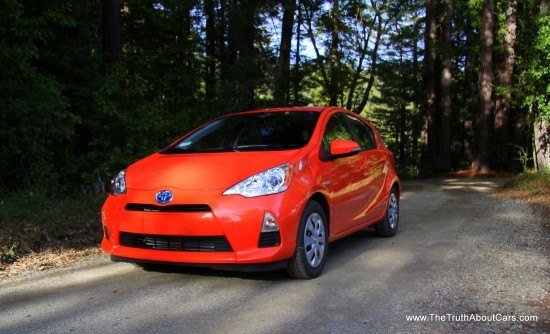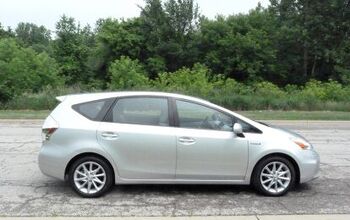Review: 2012 Toyota Prius C

In the geek world we have “Moore’s law” which states the number of transistors in ICs will double every two years. In the automotive world we have the bloat law. Every generation of a vehicle will get more powerful, heavier and physically larger than its predecessor, ultimately requiring the manufacturer to design an entirely new, smaller car to fill the void left by the original.
Back in 2001, the original Prius cost $19,995, weighed 2,765lbs and delivered 52/45MPG. Three generations later it costs $24,000, tips the scales at 3,050lbs, yields 51/48MPG and is far more practical for a family of four. Listing for $1,000 less than the original Prius and weighing a svelte 2,500lbs, the baby Prius delivers 53/46MPG of hatchback hybrid love. More important than the weight loss routine is the fact that this new Prius is “only” $4,835 more expensive than the Toyota’s Yaris (the cheapest 5-door economy car in their US lineup.) That might sound like a big chunk of change, but back in 2001, the Prius was $6,591 dearer. We can thank this price difference to Toyota’s continuing efforts to downsize their hybrid system’s footprint and price tag. Speaking of that footprint, the Prius c manages to weigh only 185lbs more than the 5-door Yaris L while the original Prius was 700lbs heavier than the Echo of the era. For once downsizing is progress.
Interior
If you’ve been inside a Prius, the interior will be “déjà vu all over again.” While the shapes look familiar, few parts are actually shared as the Prii models share the same style sheet but share few major interior trim parts. Personally, I found the traditional shifter and the high-resolution LCD in the dash a significant step-up from the Prius liftback’s low-rent display and awkward joystick. Strangely enough, the Prius c also shares little with the Yaris on which it is based, aside from a passion for hard plastics. Shoppers should know that while all Yaris models have token soft touch bits on the dash, only the top-end Prius c “four” gets some pleather dash yumminess. While some may complain about the hardness of the surfaces, the fit and finish is above average in the segment (if you exclude the Germans) and the style is less controversial than the Prius liftback.
Infotainment
Being positioned for younger and greener buyers, Toyota offers three different audio systems all with standard Bluetooth phone integration/music streaming and iPod/USB connectivity. The Prius c “one” gets a basic head unit with a small display and four speakers while the Prius c “two” uses the same radio but adds two tweeters up front. As you would expect, browsing an iPhone/iPod with 4,000+ songs on it was a royal pain. Stepping up to the Prius c “three” buys you Toyota’s 6.1-inch unit which Toyota confusingly calls “Display Audio with Navigation and Entune.” Long names aside, the Entune navigation system is an interesting blend of a decent audio head unit and integrated flash-based navigation system with smartphone data and smartphone app integration. While systems like MyFord Touch, or even Toyota’s own higher end nav systems use Sirius or XM satellite radio to deliver data content, the base Entune system pulls this data right off your smartphone using your own data plan. As a result, there’s no need for an XM or Sirius subscription like in other systems. The downside? You can’t access these services without a smartphone, so if you haven’t joined the 21st century and are still using a Motorola StarTac, you won’t be able Bing or OpenTable while you roll.
Drivetrain
Harkening back to the Prius origins isn’t just something I wax poetic about, Toyota did as well resurrecting the original 1.5L engine from the first generation Prius. While the engine is essentially the same it now produces 73HP and 82b-ft of torque, up 3HP due mostly to the removal of all the belt driven accessories including the water pump. Rather than lifting the old Hybrid Synergy Drive from the first gen Prius or borrowing the liftback’s larger transaxle, Toyota designed an all-new unit with smaller motors and considerably smaller packaging. Total system horsepower is rated at 99HP and around 125lb-ft of torque. Thanks to the Prius c’s low curb weight, the power reduction compared to the liftback isn’t obvious, with the Prius c scooting to 60 in just under 11 seconds.
Economy
If you have a Jaguar XFR, you end up flooring the car all the time to listen to the engine snarl. If you have a Prius, you hypermile. Why? Because the whole reason for the Prius’ existence is outstanding fuel economy. On my 53-mile one-way commute, my best observed fuel economy was 66MPG. This was achieved by limiting myself to 62MPH, being gentle with the pedals and keeping my road rage in check. While I may have annoyed myself at the beginning, a courteous driver keeping to just below the speed limit is unlikely to offend anyone else.
Driving the Prius c like a “normal” car (speeds up to 73MPH on the highway, keeping up with traffic and occasionally passing) made my commute average fall to a still respectable 52MPG. Over a full week and 831 miles, my 51MPG average came in just a hair above the EPA’s combined 50MPG score.
While 51MPG may sound “old hat,” the impressive thing the the Prius c maintained this high average while commuting over a 2,200ft mountain pass daily. Your mileage will obviously vary depending on your commute, your driving style and how much you use the A/C. Numbers are worthless without comparison, so here we go. The Prius c delivered 5-10 more MPGs than the Prius liftback on the same commute despite having essentially the same EPA scores (Prius 51/48MPG, Prius c 53/46MPG).
Like the Prius, the c comes in numbered packages. “One” is obviously the price leader at $18,950, achieved by “decontetning” niceties like cruise control, cargo area lights, adjustable front headrests, the center armrest and tonneau cover. The $19,900 “Two” adds extra speakers, variable intermittent wipers, 60/40 folding rear seat, cruise control, center armrest and an engine immobilizer-style key. “Three” lists for $21,635 and adds Toyota’s Entune Navigation radio with 6.1-inch touchscreen , XM and HD radio, and “Entune App” capability (Pandora, Bing, etc), keyless entry and keyless go and a telescoping steering wheel. The top-of-the-line “Four” brings 15 inch 8-spoke alloys to the party, “Softex” seats, heated front seats, fog lamps and turn signals in the side mirrors for $23,230. The “Four” can also be equipped with the $850 moonroof and an optional 16-inch alloy wheel and sport steering package for $300 (or $1150 when combined with the sunroof) topping the Prius c out at $24,380 or about the same as a base Prius liftback.
Drive/Handling
The Prius c’s road manners are almost entirely defined by weight and dimensions. To put these factors in perspective, the Prius c is 8 inches shorter than a VW Golf and 235lbs lighter than a Mini coupe (or the same as a soft-top Mazda Miata.) The Prius c’s suspension provides a solid ride that that approaches, but thankfully misses, “bouncy” – unless you buy the optional larger wheels. Unless you plan on being the only person to Autocross your hybrid, steer clear of the 16-inch wheels, as they destroy the ride and significantly enlarge the car’s turning circle from a tight 31.4, to a Buick-like 37.4 feet. With low rolling resistance tires on hand the Prius c isn’t exactly a corner carver, but thanks to the low curb weight it easily holds its own against the 40MPG compacts. Unlike those other compacts however, the Prius c continues to deliver around 30MPG when working the hybrid system hard on mountain roads. The c’s road manners under braking are improved over the liftback, as is pedal feel. While there is still a different feel to the braking versus a non-hybrid vehicle, the system is by far the most natural of Toyota’s fuel sippers. With weight reduction being king, sound isolation was a secondary concern. The Prius c’s cabin isn’t quite as noisy as the Honda Insight or Civic Hybrid, but it isn’t as quiet as some of the non-hybrid competition.
Competition
Toyota is the first to create a five-door hybrid hatchback and as a result competition is somewhat indirect. The Nissan Versa, Ford Fiesta SFE, Toyota Yaris, Hyundai Accent, and Chevrolet Sonic are the main fuel efficient hatchback competition for the baby Prius. In a more traditional shape, but similar price point, is the Honda Insight. Because fuel efficiency is the Prius’ game let’s look at the cost of purchase and gasoline (at California prices of $4.20/gallon) over 5 years. In this light, the Hyundai Accent is barely the cheapest to own at $26,095. The Yaris comes in second at $26,100, just $50 less than the Prius c two. How about the others? The Versa would be $2,840 more expensive, the Sonic $3,355 more, and the Insight narrows the gap to $1,500 more over 5 years. (These numbers are based on EPA 2008 scores and a mixture of 45% city driving, 55% highway driving, 15,000 annual miles a year and $4.20/gallon gasoline.)
The Prius c may be the smallest and cheapest member of the Prius family, but it may also be the best. It preserves the funkiness of the center mount cluster while giving up some quirkiness to convention. Not to mention, excellent fuel economy is addictive. While I may not be willing to get out of my SUV for 30 or 40MPG, 50+ MPG makes the trade something else entirely. It also makes the Yaris redundant. I can’t honestly think of a single reason to get the Yaris over the Prius c, considering that the difference in cost would be made up over the car’s life. I am frequently asked what my favorite car is, and I don’t know if I have one – but the Prius c, for its reasonable price and high fuel economy, is certainly on the very short list of cars that I would buy myself.
Toyota provided the vehicle, insurance and one tank of gas for this review
Specifications as tested
Battery charged
0-30: 3.5 Seconds
0-60: 10.78 Seconds
1/4 Mile: 18 Seconds @ 75MPH
Battery discharged
0-30: 4.05 Seconds
0-60: 13.02 Seconds
1/4 Mile: 19.05 @ 72MPH
Average fuel economy: 51.6 over 831 miles

More by Alex L. Dykes
Latest Car Reviews
Read moreLatest Product Reviews
Read moreRecent Comments
- Jbltg The more time passes, the more BMW's resemble Honda. zzzz
- VoGhost Doubling down on the sector that is shrinking (ICE). Typical Nissan.
- Dwford I don't think price is the real issue. Plenty of people buy $40-50k gas vehicles every year. It's the functionality. People are worried about range and the ability to easily and quickly recharge. Also, if you want to buy an EV these days, you are mostly limited to midsize 5 passenger crossovers. How about some body style variety??
- SCE to AUX The nose went from terrible to weird.
- Chris P Bacon I'm not a fan of either, but if I had to choose, it would be the RAV. It's built for the long run with a NA engine and an 8 speed transmission. The Honda with a turbo and CVT might still last as long, but maintenance is going to cost more to get to 200000 miles for sure. The Honda is built for the first owner to lease and give back in 36 months. The Toyota is built to own and pass down.









































Comments
Join the conversation
Your mileage comparisons to the original (1st gen US, 2nd gen Japan) Prius (the Echo one) leave out the fact that the mileage formulas were tweaked in between. Today's 55 mpg is more like yesterday's 60 or even 65.
Why do they have to make it look like it was built by Mattel? It looks like a toy, I could never take this car seriously...especially in that ugly Skittles orange color.